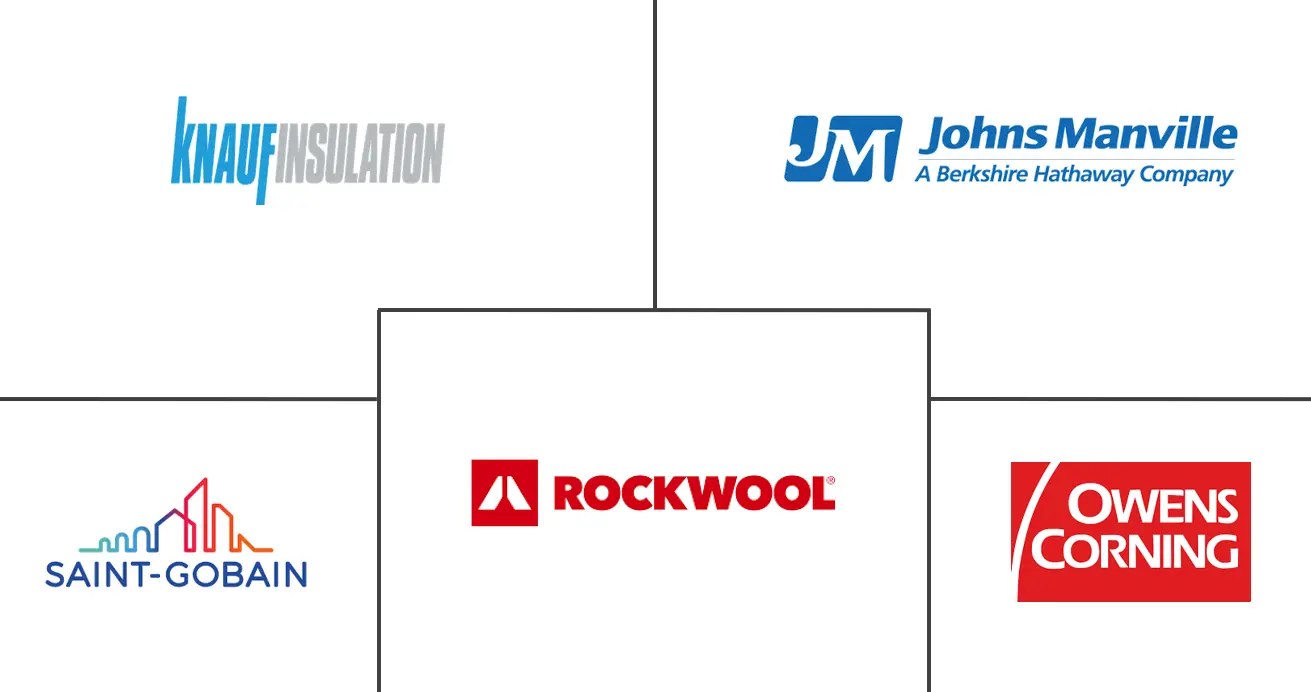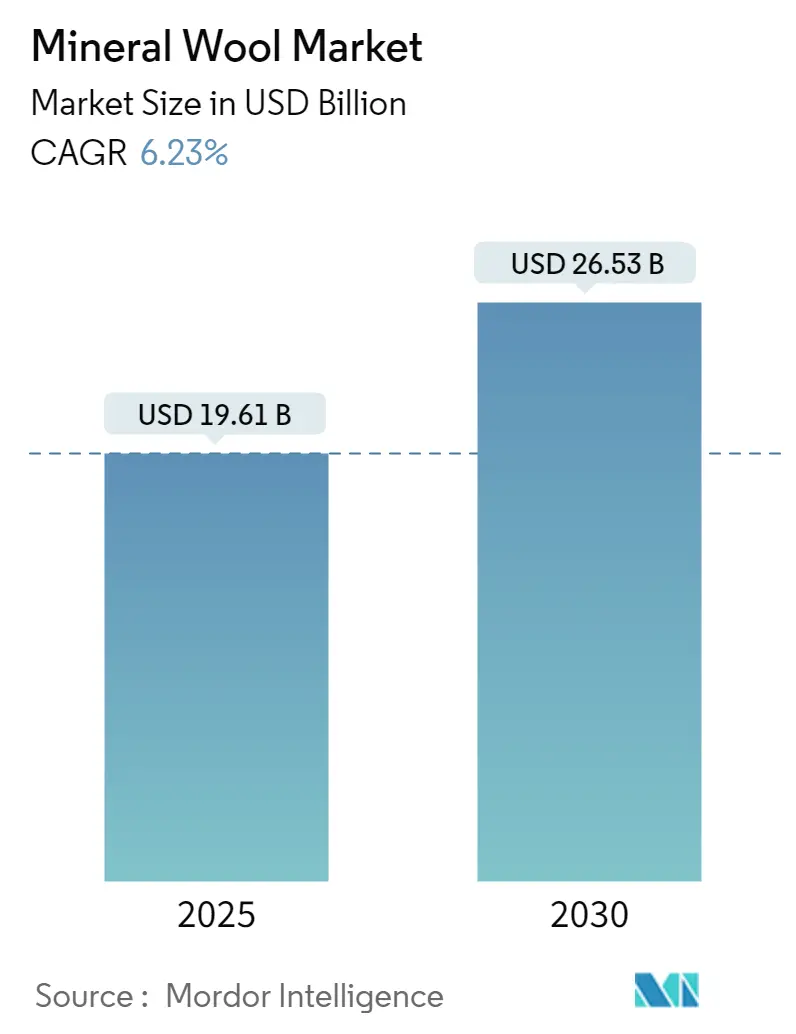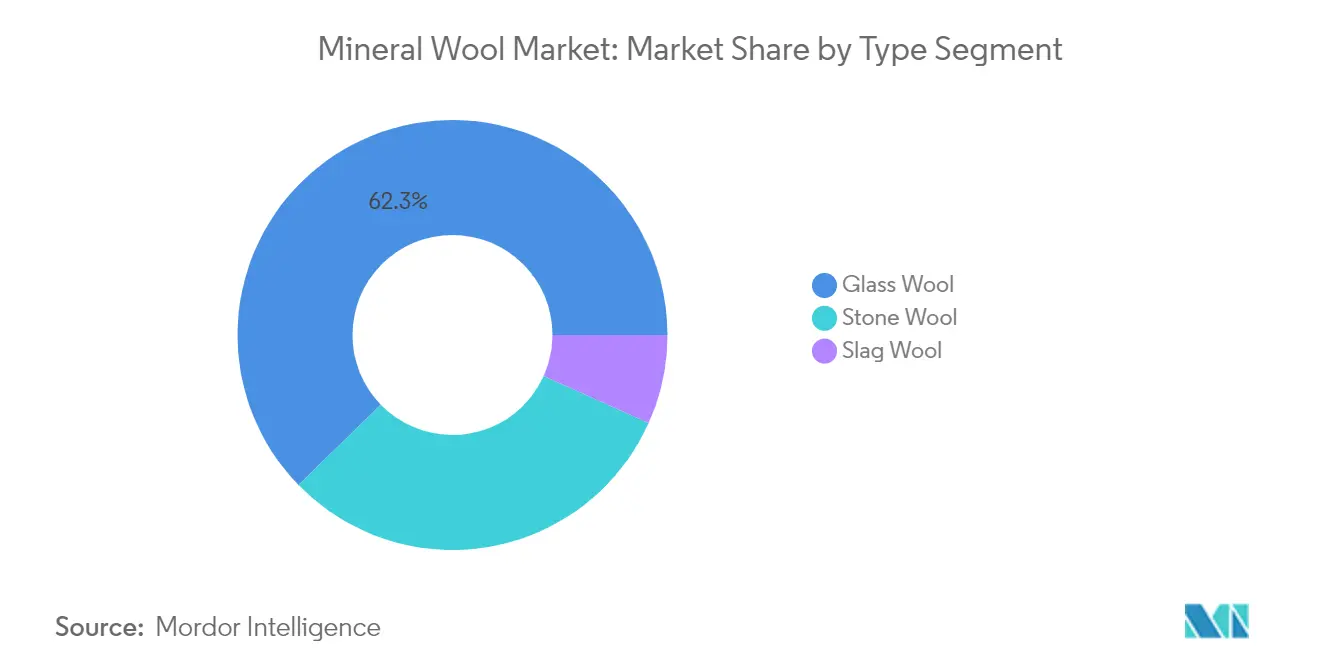Mineral Wool Market Analysis
The Mineral Wool Market size is estimated at USD 19.61 billion in 2025, and is expected to reach USD 26.53 billion by 2030, at a CAGR of 6.23% during the forecast period (2025-2030).
The mineral wool industry continues to experience robust growth driven by increasing industrialization and urbanization across major economies. The material's superior thermal insulation and acoustic insulation properties have positioned it as a preferred choice across diverse applications, from building insulation to industrial process equipment. Notably, major industry player Rockwool International reported a significant 20% year-over-year increase in insulation sales to EUR 2.29 billion in 2021, reflecting the strong market demand. The industry has also witnessed substantial technological advancements in manufacturing processes, leading to enhanced product performance and sustainability characteristics.
The construction sector remains a crucial end-user segment, with particular emphasis on energy-efficient building material solutions. In Germany, a key market indicator showed positive momentum with 29,597 new dwelling permits issued in October 2021, demonstrating the sustained demand for residential construction. The industry has seen increased adoption of mineral wool in both new construction and renovation projects, driven by stricter building codes and growing awareness of energy efficiency benefits. Manufacturers have responded by developing innovative products with improved thermal insulation performance and fire-resistant insulation properties.
The industrial applications segment has witnessed significant expansion, particularly in power generation, manufacturing, and process industries. The material's ability to withstand high temperatures while providing excellent industrial insulation has made it indispensable in industrial settings. The automotive and transportation sectors have emerged as growing application areas, with mineral wool being increasingly used for thermal insulation and acoustic insulation in vehicles. The industry has also seen rising demand from the marine and offshore sectors, where mineral wool's fire-resistant properties are particularly valuable.
The market has experienced a notable shift toward sustainable insulation and environmentally friendly products. Manufacturers are increasingly focusing on developing products with higher recycled content and improved environmental performance. The industry has also witnessed growing investment in research and development to enhance product characteristics and explore new applications. The recyclability of glass mineral wool has become a significant focus area, with manufacturers implementing advanced recycling technologies and processes to reduce environmental impact. This trend aligns with broader industry movements toward circular economy principles and sustainable manufacturing practices.
Mineral Wool Market Trends
Growing Building and Construction Industry
The global building and construction industry has emerged as a primary driver for the mineral wool market, with projections indicating the sector will reach a substantial revenue of USD 4.4 trillion by 2030. The construction sector's robust growth is attributed to multiple factors, including increasing urbanization, the development of new cities, growing migration to urban areas, and the continuous renewal of aging infrastructure in established metropolitan areas. This expansion is evidenced by the United States' construction sector, which hosts 14,200 road and highway construction businesses as of 2023, representing a 0.7% increase from the previous year. The scale of construction activities is further demonstrated by significant infrastructure investments, such as China's commitment of USD 1.43 trillion for major construction projects through 2025.
The residential construction segment has shown particularly strong momentum, with substantial investments in housing development projects worldwide. For instance, Shanghai's ambitious development plan includes an investment of USD 38.7 billion over three years, while Guangzhou has initiated 16 new infrastructure projects valued at USD 8.09 billion. The growing emphasis on sustainable and energy-efficient buildings has also contributed to increased demand for mineral wool insulation materials. This trend is reinforced by the material's exceptional properties, including non-combustibility, thermal resistance capabilities exceeding 1,000°C, and its effectiveness as a fire-retardant product for applications in ceilings, fire-resistant doors, and partition walls. The building material industry is increasingly recognizing these benefits, driving further adoption.
Regulatory Support to Increase Energy Efficiency
Government regulations and initiatives promoting energy efficiency have become a significant driver for the mineral wool market, with numerous countries implementing stringent building codes and energy conservation policies. The European Commission has taken a leading role by adopting comprehensive proposals to reform climate, energy, transportation, and taxation policies, aiming to reduce net greenhouse gas emissions by at least 55% by 2030 compared to 1990 levels. This commitment is supported by the Social Climate Fund, which has allocated EUR 72.2 billion over seven years for building rehabilitation and sustainable mobility initiatives. Additionally, the Commission has established ambitious targets, including the requirement for Union member states to rehabilitate at least 3% of the total floor area of all public buildings annually and achieve 49% renewables in buildings by 2030.
National-level initiatives have further strengthened the regulatory framework supporting energy efficiency. The Canadian government's Greener Homes Grant exemplifies this trend, offering homeowners up to USD 5,000 for energy-efficient renovations and an additional USD 600 to assist with home energy evaluation costs. Similar initiatives have been implemented across the Middle East and African countries, with nations such as Algeria, Jordan, Sudan, Syria, and the United Arab Emirates establishing comprehensive energy-efficient policies. These regulations include the development of energy efficiency standards for home appliances, thermal insulation enforcement in residential and commercial buildings, and the creation of codes of practice for building insulation. The growing emphasis on noise pollution reduction, as outlined in ISO standards and recommendations established by regulatory agencies like DEFRA's Noise Policy Vision, has also contributed to increased demand for soundproofing material such as mineral wool.
Segment Analysis: TYPE
Glass Wool Segment in Mineral Wool Market
Glass wool continues to dominate the global mineral wool market, commanding approximately 62% market share in 2024. This significant market position is attributed to its superior thermal insulation characteristics that make substantial contributions to addressing climate change and energy conservation challenges. The material's unique structure provides enhanced safety features by reducing fire risks while offering excellent acoustic insulation properties. Glass wool's growing popularity stems from its versatility in applications ranging from residential insulation and commercial buildings to industrial facilities. The material's environmental credentials are particularly noteworthy, as it is manufactured from recycled glass and sand or cullet, making it a fully natural mineral fiber insulation option. Its cost-effectiveness, stemming from the use of recycled materials, combined with its exceptional insulation properties, has solidified its position as the preferred choice in the mineral wool market.
Stone Wool Segment in Mineral Wool Market
Stone wool, also known as mineral wool, represents a significant segment in the market, manufactured from recovered slag and natural basalt rock. This segment has established itself as a crucial component in the construction and industrial sectors due to its distinctive properties. Stone wool's ability to withstand mold, fire, and water makes it an exceptionally versatile and durable building material. The material's superior thermal insulation and sound absorption capabilities, compared to standard fiberglass, have driven its adoption across various applications. Its non-combustible nature and ability to endure temperatures up to 1,177 degrees Celsius make it particularly valuable in fire-resistant insulation applications. The dense nature of stone wool fibers effectively prevents air passage, significantly limiting sound transmission and enhancing its appeal in acoustic insulation applications.
Remaining Segments in Mineral Wool Market by Type
Slag wool represents a smaller but important segment in the mineral wool market, offering unique advantages in specific applications. Made primarily from blast furnace slag combined with natural rock and binders, slag wool insulation provides excellent thermal efficiency and strength characteristics. This segment has carved out a niche in specialized applications such as industrial environments, large vessels, and heat exchangers. The material's ability to provide effective industrial insulation while maintaining structural integrity in demanding environments has made it particularly valuable in industrial applications. Its contribution to energy efficiency and environmental sustainability, coupled with its proven track record in commercial and industrial settings, continues to maintain its relevance in the overall mineral wool market landscape.
Segment Analysis: PRODUCT TYPE
Blanket Segment in Mineral Wool Market
The blanket segment dominates the global mineral wool market, commanding approximately 68% of the total market share in 2024. This segment's prominence is attributed to its versatile applications across various industries, particularly in building and construction. Mineral wool blankets are highly preferred due to their excellent thermal insulation and acoustic properties, especially for medium and low-frequency sound cancellation, making them ideal for enhancing working conditions. The segment's popularity is further bolstered by its lightweight nature, ease of installation at construction sites, and fire-retardant properties. Additionally, aluminum foil-faced mineral wool blankets are experiencing increased demand due to their compliance with green building standards and environmental protection requirements, while avoiding harmful substances like formaldehyde and phenol. The segment maintains consistent thermal insulation performance across both high and low-temperature environments, making it particularly valuable for industrial insulation applications.
Board Segment in Mineral Wool Market
The board segment represents a significant portion of the mineral wool market, with manufacturers focusing on developing innovative board products to meet evolving industry demands. These boards are increasingly being utilized in commercial roofs, basement walls, and various building envelope applications. The versatility of mineral wool boards is evident in their wide range of densities and thicknesses, typically ranging from 1" to 4", catering to diverse application requirements. Leading manufacturers like Johns Manville, Owens Corning, and Rockwool continue to drive innovation in this segment, enhancing product performance and application scope. The segment's growth is particularly notable in the context of increasing demand for sound absorption materials in hotels, KTVs, stadiums, and other commercial spaces where acoustic performance is crucial.
Remaining Segments in Product Type
The loose wool and other product types segments complete the mineral wool market portfolio, each serving specific industrial and commercial applications. Loose wool is particularly valued for its flexibility in application, especially in situations where prefabricated insulation materials are challenging to install. This segment is characterized by its excellent handling properties and versatility in various temperature ranges. The other product types segment, which includes specialized forms like mineral wool pipe and spray applications, caters to specific industrial requirements and customized solutions. These segments are essential in providing comprehensive insulation solutions for unique architectural designs and specialized industrial applications where standard formats may not be suitable.
Segment Analysis: END-USER INDUSTRY
Building and Construction Segment in Mineral Wool Market
The building and construction segment continues to dominate the global mineral wool market, accounting for approximately 60% of the total market value in 2024. This significant market share is driven by the increasing adoption of mineral wool in various construction applications due to its excellent thermal insulation and acoustic insulation properties. The segment's growth is supported by stringent building energy efficiency regulations worldwide, particularly in developed regions, as well as the rising focus on sustainable and energy-efficient construction practices. The expansion of residential insulation and commercial construction activities, especially in emerging economies, further strengthens this segment's position. Additionally, the growing emphasis on fire safety in buildings and the material's superior fire-resistant properties contribute to its widespread use in the construction sector.
Industrial and Consumer Appliances Segment in Mineral Wool Market
The industrial and consumer appliances segment is projected to experience substantial growth at approximately 6% CAGR from 2024 to 2029. This growth is primarily attributed to the increasing demand for high-temperature industrial insulation in industrial processes and equipment. The segment's expansion is driven by the rising adoption of mineral wool in various industrial applications, including pipe insulation, industrial furnaces, and process equipment, where maintaining optimal temperature control is crucial. The material's excellent thermal performance, fire resistance, and durability make it an ideal choice for industrial applications. Furthermore, the growing focus on energy efficiency in industrial operations and the increasing adoption of mineral wool in consumer appliances for thermal and acoustic insulation purposes contribute to the segment's robust growth trajectory.
Remaining Segments in End-User Industry
The automotive and transportation segment, along with other end-user industries, continues to play a vital role in the mineral wool market. In the automotive sector, mineral wool is extensively used for thermal and acoustic insulation in vehicles, contributing to improved comfort and energy efficiency. The material's lightweight properties and excellent sound absorption capabilities make it particularly suitable for automotive applications. Other end-user industries encompass diverse applications including marine and offshore insulation, where mineral wool's fire resistance and durability are highly valued. These segments collectively contribute to the market's diversification and demonstrate the versatility of mineral wool across various industrial applications.
Mineral Wool Market Geography Segment Analysis
Mineral Wool Market in Asia-Pacific
The Asia-Pacific region represents a dominant force in the global mineral wool market, driven by rapid industrialization and urbanization across major economies like China, India, Japan, and South Korea. The region's construction sector growth, particularly in residential and commercial buildings, has been a key driver for mineral wool demand. Stringent building energy efficiency regulations and increasing awareness about sustainable construction practices have further boosted market growth. The region's automotive and industrial sectors also contribute significantly to mineral wool consumption, particularly in thermal insulation and acoustic insulation applications.
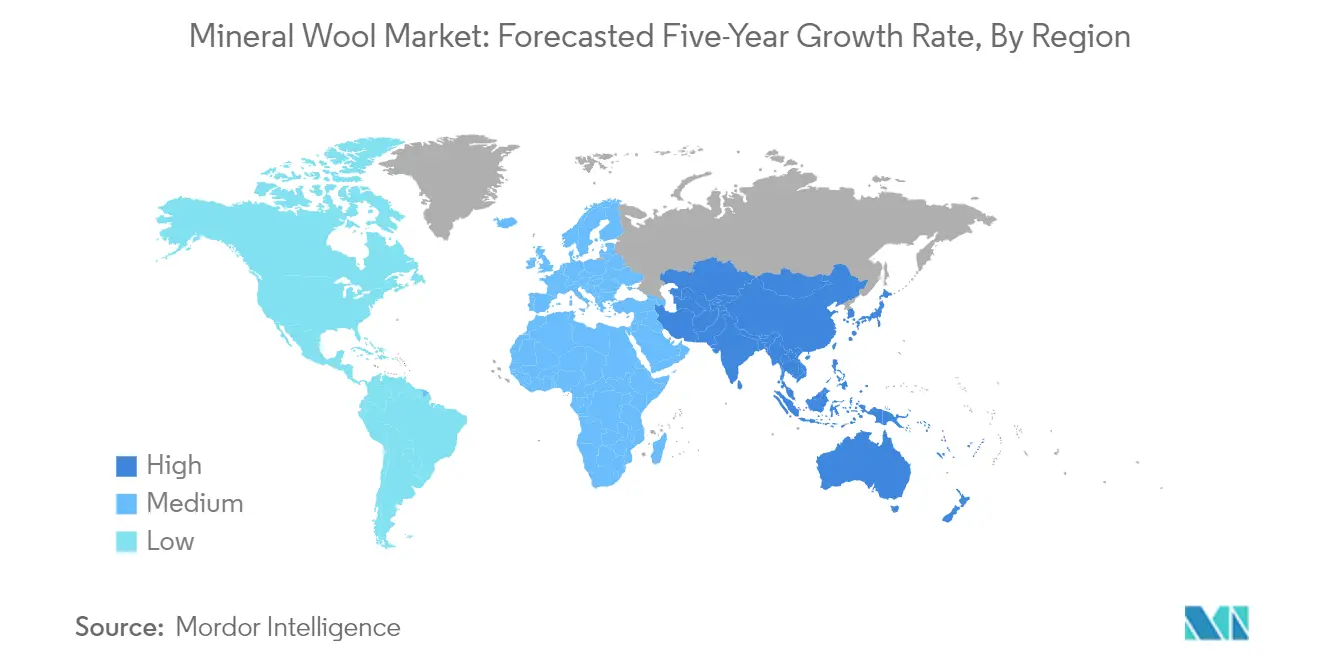
Mineral Wool Market in China
China dominates the Asia-Pacific mineral wool market, holding approximately 50% of the regional market share in 2024. The country's leadership position is supported by its massive construction industry, which remains the largest globally. China's focus on energy-efficient buildings and sustainable construction practices has driven significant demand for mineral wool insulation products. The government's initiatives in smart city construction and green building development have created substantial opportunities for market growth. The country's robust manufacturing sector, particularly in automotive and industrial applications, further strengthens its position in the mineral wool market.
Mineral Wool Market in India
India emerges as the fastest-growing market in the Asia-Pacific region, with a projected growth rate of approximately 8% during 2024-2029. The country's rapid urbanization and increasing focus on energy-efficient construction have been key growth drivers. Government initiatives promoting sustainable building practices and energy conservation have created favorable conditions for mineral wool adoption. The expansion of the industrial sector, particularly in automotive manufacturing and infrastructure development, has further accelerated market growth. India's commitment to developing smart cities and implementing stricter building energy codes continues to drive demand for mineral wool insulation products.
Mineral Wool Market in North America
The North American mineral wool market demonstrates strong growth potential, supported by increasing emphasis on energy-efficient construction and stringent building codes across the United States, Canada, and Mexico. The region's focus on sustainable building practices and renovation of existing infrastructure has created steady demand for mineral wool products. The automotive and industrial sectors also contribute significantly to market growth, particularly in thermal insulation and acoustic insulation applications. The region's commitment to reducing carbon emissions and improving building energy efficiency continues to drive innovation in mineral wool products.
Mineral Wool Market in United States
The United States maintains its position as the largest mineral wool market in North America, commanding approximately 86% of the regional market share in 2024. The country's leadership is driven by its extensive construction industry and strong focus on energy-efficient building solutions. The implementation of stringent building codes and energy efficiency standards across states has created consistent demand for mineral wool insulation. The country's robust industrial sector and growing emphasis on sustainable construction practices continue to support market growth.
Mineral Wool Market in Canada
Canada emerges as the fastest-growing market in North America, with a projected growth rate of approximately 5% during 2024-2029. The country's growth is driven by increasing adoption of energy-efficient building solutions and stringent building codes. Government initiatives promoting sustainable construction and energy conservation have created favorable conditions for mineral wool adoption. The country's cold climate necessitates effective insulation solutions, further driving demand for mineral wool products. Canada's commitment to reducing carbon emissions and improving building energy efficiency continues to create opportunities for market expansion.
Mineral Wool Market in Europe
The European mineral wool market demonstrates strong market fundamentals, supported by stringent energy efficiency regulations and sustainable building practices across Germany, France, the United Kingdom, and Italy. The region's commitment to reducing carbon emissions and improving building energy performance has created consistent demand for mineral wool insulation. The renovation wave across European countries and increasing focus on green building solutions continue to drive market growth. The region's industrial and automotive sectors also contribute significantly to mineral wool consumption.
Mineral Wool Market in Germany
Germany maintains its position as the largest mineral wool market in Europe, driven by its extensive construction industry and strong focus on energy-efficient building solutions. The country's leadership in sustainable construction practices and stringent building energy codes has created steady demand for mineral wool products. Germany's robust industrial sector, particularly in automotive and manufacturing applications, further strengthens its position in the market. The country's commitment to energy transition and building renovation continues to drive innovation in insulation solutions.
Mineral Wool Market in United Kingdom
The United Kingdom emerges as the fastest-growing market in Europe, driven by increasing focus on building energy efficiency and sustainable construction practices. The country's commitment to reducing carbon emissions has created favorable conditions for mineral wool adoption. Government initiatives promoting energy-efficient renovation and new construction continue to drive market growth. The UK's industrial sector and growing emphasis on acoustic insulation in commercial buildings further support market expansion.
Mineral Wool Market in South America
The South American mineral wool market, primarily represented by Brazil and Argentina, shows steady growth potential despite economic challenges in the region. Brazil emerges as both the largest and fastest-growing market in the region, driven by its extensive construction industry and increasing focus on energy-efficient building material solutions. The region's industrial sector, particularly in automotive and manufacturing applications, contributes significantly to market growth. Government initiatives promoting sustainable construction practices and energy efficiency improvements continue to create opportunities for market expansion across South America.
Mineral Wool Market in Middle East & Africa
The Middle East & Africa mineral wool market demonstrates growing potential, with Saudi Arabia and South Africa leading regional development. South Africa represents the largest market in the region, supported by its diverse industrial sector and growing construction industry. Saudi Arabia emerges as the fastest-growing market, driven by ambitious construction projects and increasing focus on energy-efficient building material solutions. The region's industrial development and growing emphasis on sustainable construction practices continue to create opportunities for market expansion. Government initiatives promoting energy efficiency and sustainable building practices further support market growth across the region.
Mineral Wool Industry Overview
Top Companies in Mineral Wool Market
The mineral wool market is characterized by intense competition among major players who are actively pursuing innovation and expansion strategies. Companies are focusing on developing sustainable and energy-efficient mineral wool insulation solutions while investing in R&D to enhance product performance and applications across construction, automotive, and industrial sectors. Market leaders are strengthening their positions through strategic acquisitions, plant expansions, and technological advancements in manufacturing processes. The industry has witnessed significant investments in new production facilities across emerging markets, particularly in Asia-Pacific and Eastern Europe, to meet growing regional demand. Companies are also emphasizing backward integration of operations, development of specialized products for specific applications, and enhancement of distribution networks to maintain a competitive advantage. Additionally, there is an increasing focus on environmentally sustainable production methods and recycling capabilities to align with global sustainability trends.
Consolidated Market with Strong Regional Players
The global mineral wool market exhibits a partially consolidated structure dominated by multinational corporations with a strong regional presence. Major players like Rockwool International AS, Saint Gobain, Knauf Insulation, and Owens Corning have established themselves as market leaders through extensive manufacturing networks, robust distribution channels, and comprehensive product portfolios. These companies leverage their technological expertise, brand reputation, and economies of scale to maintain market leadership. The industry has witnessed significant merger and acquisition activities, with larger players acquiring regional manufacturers to expand geographical presence and enhance production capabilities. The market also features several specialized regional players who maintain competitive positions in specific geographical areas through local market knowledge and customized product offerings.
The competitive dynamics are shaped by high entry barriers due to the capital-intensive nature of operations, technical expertise requirements, and established player dominance in key markets. Market leaders are increasingly focusing on vertical integration strategies to control raw material costs and ensure supply chain efficiency. The industry has seen strategic partnerships and collaborations among players to enhance technological capabilities and market reach. Regional players are strengthening their positions through a focus on specific application segments and development of niche products, while global players continue to expand their presence through greenfield investments and acquisitions in emerging markets.
Innovation and Sustainability Drive Future Success
Success in the mineral wool market increasingly depends on companies' ability to innovate while maintaining cost competitiveness and sustainability credentials. Market incumbents are focusing on developing advanced manufacturing technologies, expanding production capacities, and strengthening their distribution networks to maintain market share. Companies are investing in research and development to create differentiated products with enhanced performance characteristics, particularly for specialized applications in construction and industrial sectors. The ability to offer comprehensive solutions, including technical support and application expertise, has become crucial for maintaining a competitive advantage. Players are also emphasizing digital transformation initiatives to improve operational efficiency and customer service capabilities.
Future market success will be significantly influenced by companies' ability to address growing environmental concerns and regulatory requirements while meeting evolving customer needs. Manufacturers are investing in sustainable production processes and developing products with higher recycled content to meet stringent environmental regulations. The industry is witnessing increased focus on developing solutions for emerging applications in renewable energy and industrial sectors. Companies are also strengthening their positions through strategic partnerships with construction companies and industrial users to ensure steady demand. The ability to maintain price competitiveness while offering high-quality products and technical support services will remain crucial for success in this market.
Mineral Wool Market Leaders
-
Rockwool International AS
-
Saint Gobain
-
Knauf Insulation
-
Owens Corning
-
Johns Manville
- *Disclaimer: Major Players sorted in no particular order
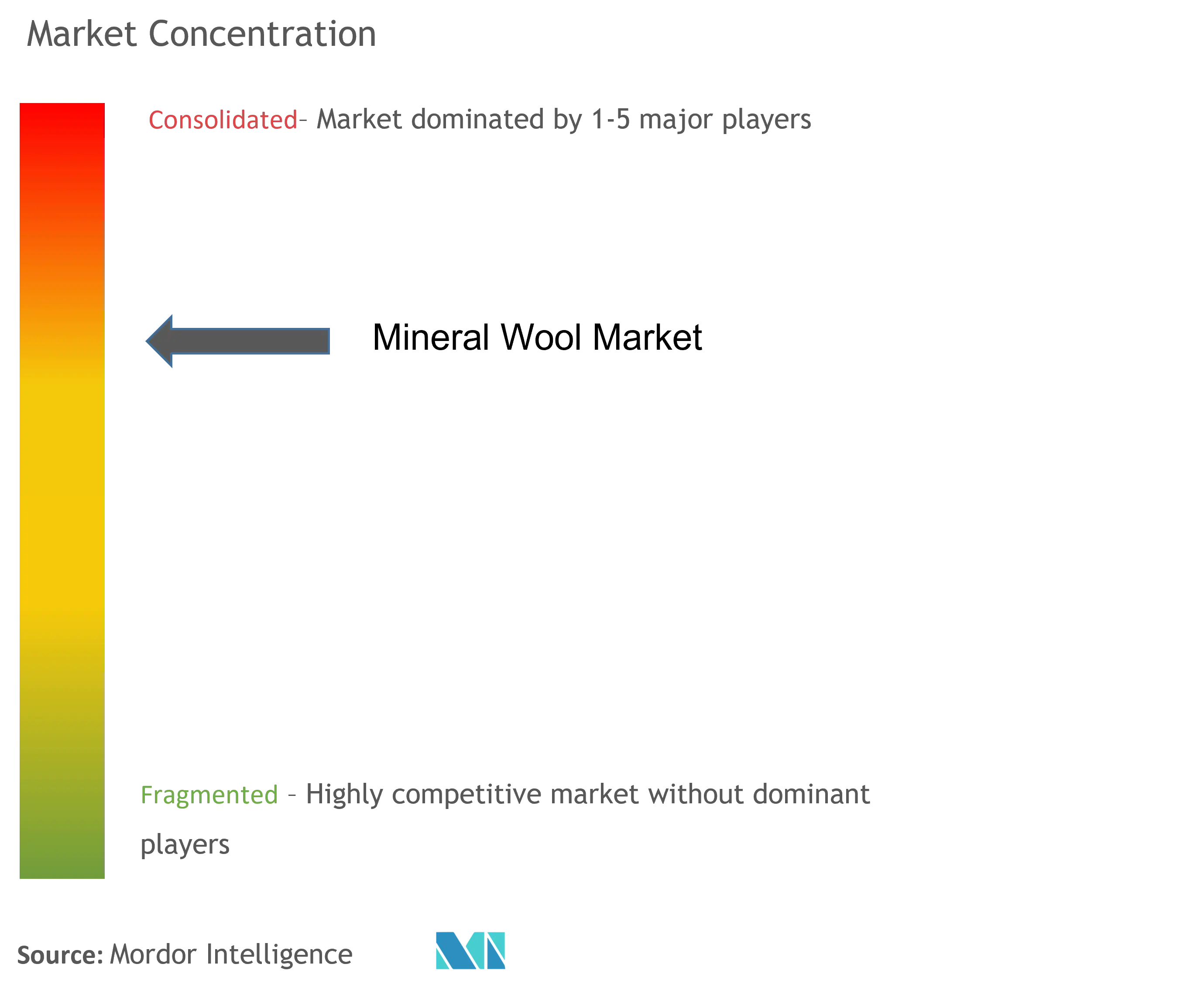
Mineral Wool Market News
- February 2023: Saint-Gobain entered into an agreement for the acquisition of Indian market leader and glass wool insulation producer Twiga Fiberglass.
- January 2022: Knauf Insulation acquired a glass mineral wool plant in Central Romania to meet the increasing demand for mineral wool in the region. The acquisition supported the company's growth ambitions and added enhanced capacity to meet increasing demand for solutions across the Eastern European and CIS regions.
Mineral Wool Market Report - Table of Contents
1. INTRODUCTION
- 1.1 Study Assumptions
- 1.2 Scope of the Study
2. RESEARCH METHODOLOGY
3. EXECUTIVE SUMMARY
4. MARKET DYNAMICS
-
4.1 Drivers
- 4.1.1 Growing Building and Construction Industry
- 4.1.2 Regulatory Support to Increase Energy Efficiency
-
4.2 Restraints
- 4.2.1 Health Hazards Related to Mineral Wool
- 4.2.2 Availability of Cheap Insulating Materials
- 4.3 Industry Value Chain Analysis
-
4.4 Porter's Five Force Analysis
- 4.4.1 Bargaining Power of Suppliers
- 4.4.2 Bargaining Power of Consumers
- 4.4.3 Threat of New Entrants
- 4.4.4 Threat of Substitute Products and Services
- 4.4.5 Degree of Competition
5. MARKET SEGMENTATION (Market Size in Value)
-
5.1 Type
- 5.1.1 Glass Wool
- 5.1.2 Stone Wool
- 5.1.3 Slag Wool
-
5.2 Product Type
- 5.2.1 Board
- 5.2.2 Blanket
- 5.2.3 Loose Wool
- 5.2.4 Other Product Types
-
5.3 End-user Industry
- 5.3.1 Automotive and Transportation
- 5.3.2 Building and Construction
- 5.3.3 Industrial and Consumer Appliances
- 5.3.4 Other End-user industries
-
5.4 Geography
- 5.4.1 Asia-Pacific
- 5.4.1.1 China
- 5.4.1.2 India
- 5.4.1.3 Japan
- 5.4.1.4 South Korea
- 5.4.1.5 Rest of Asia-Pacific
- 5.4.2 North America
- 5.4.2.1 United States
- 5.4.2.2 Canada
- 5.4.2.3 Mexico
- 5.4.3 Europe
- 5.4.3.1 Germany
- 5.4.3.2 France
- 5.4.3.3 United Kingdom
- 5.4.3.4 Italy
- 5.4.3.5 Rest of Europe
- 5.4.4 South America
- 5.4.4.1 Brazil
- 5.4.4.2 Argentina
- 5.4.4.3 Rest of South America
- 5.4.5 Middle-East and Africa
- 5.4.5.1 Saudi Arabia
- 5.4.5.2 South Africa
- 5.4.5.3 Rest of Middle-East and Africa
6. COMPETITIVE LANDSCAPE
- 6.1 Mergers and Acquisitions, Joint Ventures, Collaborations, and Agreements
- 6.2 Market Share (%) Analysis **/ Market Ranking Analysis
- 6.3 Strategies Adopted by Leading Players
-
6.4 Company Profiles
- 6.4.1 Ecowool
- 6.4.2 Great Lakes Textiles
- 6.4.3 Johns Manville
- 6.4.4 Kingspan Group
- 6.4.5 Knauf Insulation
- 6.4.6 National Industrial Co.
- 6.4.7 NTN OOD
- 6.4.8 Owens Corning
- 6.4.9 Rockwool International AS
- 6.4.10 Rosewool Insulation Refractory Co. Ltd.
- 6.4.11 Saint Gobain
- *List Not Exhaustive
7. MARKET OPPORTUNITIES AND FUTURE TRENDS
- 7.1 Increasing Number of Power Plants in Asia-Pacific
- 7.2 Recyclability of Glass Mineral Wools
Mineral Wool Industry Segmentation
Mineral wool is a fiber made of natural or synthetic minerals or metal oxides. The synthetic form is generally referred to as synthetic materials, including fiberglass, ceramic fibers, and stone wool. The mineral wool market is segmented by type, product type, end-user industry, and geography. By type, the market is segmented into glass wool, stone wool, and slag wool. By product type, the market is segmented into board, blanket, loose wool, and other product types. By end-user industry, the market is segmented into automotive and transportation, building and construction, industrial and consumer appliances, and other end-user industries. The report also covers the market size and forecasts for the geotextile market in 15 countries across major regions. For each segment, market sizing and forecasts have been done on the basis of revenue (USD million).
| Type | Glass Wool | ||
| Stone Wool | |||
| Slag Wool | |||
| Product Type | Board | ||
| Blanket | |||
| Loose Wool | |||
| Other Product Types | |||
| End-user Industry | Automotive and Transportation | ||
| Building and Construction | |||
| Industrial and Consumer Appliances | |||
| Other End-user industries | |||
| Geography | Asia-Pacific | China | |
| India | |||
| Japan | |||
| South Korea | |||
| Rest of Asia-Pacific | |||
| North America | United States | ||
| Canada | |||
| Mexico | |||
| Europe | Germany | ||
| France | |||
| United Kingdom | |||
| Italy | |||
| Rest of Europe | |||
| South America | Brazil | ||
| Argentina | |||
| Rest of South America | |||
| Middle-East and Africa | Saudi Arabia | ||
| South Africa | |||
| Rest of Middle-East and Africa | |||
Mineral Wool Market Research FAQs
How big is the Mineral Wool Market?
The Mineral Wool Market size is expected to reach USD 19.61 billion in 2025 and grow at a CAGR of 6.23% to reach USD 26.53 billion by 2030.
What is the current Mineral Wool Market size?
In 2025, the Mineral Wool Market size is expected to reach USD 19.61 billion.
Who are the key players in Mineral Wool Market?
Rockwool International AS, Saint Gobain, Knauf Insulation, Owens Corning and Johns Manville are the major companies operating in the Mineral Wool Market.
Which is the fastest growing region in Mineral Wool Market?
Asia Pacific is estimated to grow at the highest CAGR over the forecast period (2025-2030).
Which region has the biggest share in Mineral Wool Market?
In 2025, the Asia Pacific accounts for the largest market share in Mineral Wool Market.
What years does this Mineral Wool Market cover, and what was the market size in 2024?
In 2024, the Mineral Wool Market size was estimated at USD 18.39 billion. The report covers the Mineral Wool Market historical market size for years: 2019, 2020, 2021, 2022, 2023 and 2024. The report also forecasts the Mineral Wool Market size for years: 2025, 2026, 2027, 2028, 2029 and 2030.
Our Best Selling Reports
Mineral Wool Market Research
Mordor Intelligence provides a comprehensive analysis of the mineral wool market. This includes detailed insights into the rock wool, stone wool, and slag wool segments. Our extensive research methodology examines the full range of building material and construction material applications. We focus particularly on thermal insulation, acoustic insulation, and building insulation solutions. The report offers a detailed analysis of the industrial insulation, commercial insulation, and residential insulation sectors. It also addresses emerging trends in HVAC insulation and fire resistant insulation.
Stakeholders in the building material industry and construction material industry benefit from our actionable insights. These are available in an easy-to-read report PDF format for download. The analysis covers crucial aspects of sustainable insulation development, mineral wool insulation applications, and soundproofing material innovations. Our research spans the complete value chain, from industrial mineral wool manufacturing to end-user applications in the thermal insulation industry and acoustic insulation industry. The report provides valuable intelligence for decision-makers in the building insulation market, commercial insulation market, and industrial insulation market. This supports strategic planning and market expansion initiatives.

